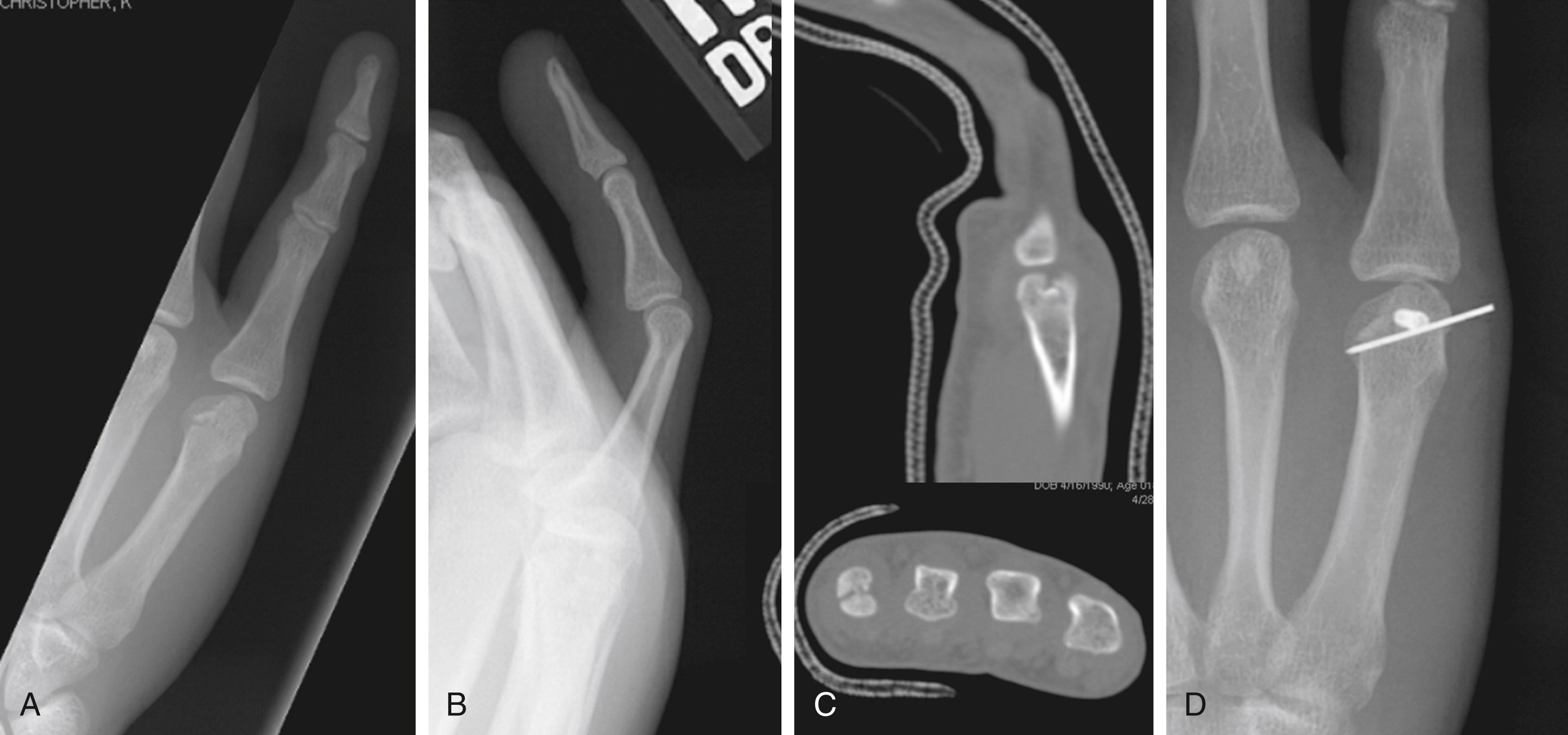Physical Address
304 North Cardinal St.
Dorchester Center, MA 02124
Metacarpal fractures are one of the most commonly sustained hand fractures and the overwhelming majority of these fractures may be treated nonoperatively with or without immobilization. Surgical intervention is frequently considered when the fracture leads to a functionally limiting or aesthetically displeasing deformity. In general, intra-articular displacement, malrotation, fracture shortening of ≥5 mm, and angulation that can cause compensatory posturing or extensor lag are not well tolerated (see the “Indications for Surgical Treatment” section of Chapter 74 ). Several methods of surgical treatment exist, each with its own advantages and disadvantages. Closed reduction with percutaneous pinning is inexpensive, readily available, and minimally invasive but carries the risk of pin site infection and stiffness due to associated immobilization. Intramedullary screw fixation is a minimally invasive option that avoids the risk associated with pin retention but is more costly and technically demanding. Other fractures are better managed with open reduction and internal fixation. In particular, intra-articular fractures with displacement, multiple metacarpal fractures, or significantly displaced fractures may require open surgical treatment through either a volar or dorsal approach highlighted in this chapter ( Table 76.1 ).
| Volar | Dorsal |
|---|---|
| Metacarpal head fracture involving volar 50% | Metacarpal head fracture involving dorsal 50% |
| Metacarpal head fracture with metacarpophalangeal joint dislocation | Metacarpal neck and shaft fracture |
| Base of thumb metacarpal fracture | Metacarpal base fracture with or without carpometacarpal dislocation |
| Multiple adjacent metacarpals |
The dorsal approach for metacarpal fracture fixation is by far most often utilized and is ideal for metacarpal neck, shaft, or base fractures. Minimal dissection is needed to reach the level of the metacarpal and the typical apex dorsal deformity can be corrected through this approach. Additionally, metacarpal head fractures that involve the dorsal half of the articular surface or a dorsal metacarpophalangeal (MCP) joint dislocation may be approached through a dorsal extensor splitting or sparing approach. The complexity of these metacarpal head fractures may require a combined volar and dorsal approach in order to attain and maintain an anatomic reduction. , Carpometacarpal (CMC) base fractures with or without dislocation may also necessitate open reduction and fixation. The typical direction of dislocation is dorsal and a dorsal approach is used in this scenario to visualize an anatomic reduction.
While the majority of metacarpal fractures are adequately treated through a dorsal approach, the volar approach can be more appropriate for certain fractures and useful to be familiar with. Metacarpal head fractures that are articular shear fractures involving the volar aspect of the head can be better accessed through a volar A1 pulley approach. Displaced thumb metacarpal base fractures, Bennett or Rolando fractures, may be approached through a standard dorsal approach similar to the nonthumb metacarpals, a volar Wagner approach, or a direct volar approach depending on fracture pattern and surgeon’s preference.
Other considerations in surgical decision-making in metacarpal fractures involve the use of arthroscopy as an aid and the use of wide-awake local anesthesia with no tourniquet (WALANT) techniques. Arthroscopy is especially helpful when performing closed or open reduction of intra-articular thumb metacarpal base fractures to confirm anatomic reduction. As WALANT becomes a more commonly employed method of fracture fixation, anesthetic risk and cost can be minimized for patients. WALANT has the added advantages of allowing direct observation of active range of motion to assess rotation and less surgical waste. It can be used in the setting of closed or open treatment but has been traditionally reserved for relatively uncomplicated fracture patterns. ,
The preoperative evaluation of metacarpal fractures proceeds in a similar fashion as for other long bone fractures. Soft tissues are assessed for open wounds, tendon, or muscle injury, and compartment syndrome. A thorough neurovascular examination and evaluation of each tendinous unit in the hand are critical to choosing the most effective surgical approach. The initial imaging of choice when a metacarpal fracture is suspected is a three- or four-view radiographic evaluation. With radiographs alone, the fracture location, pattern, displacement, and ultimately the necessary approach for optimal fixation can be determined. It must be remembered that the metacarpals form a transverse arch and, consequently, the hand must be supinated or pronated to view the ulnar or radial metacarpals in the true lateral plane, respectively. Concomitant injuries may also be diagnosed on radiographs that can affect surgical treatment. Proximal phalanx fractures or carpal fractures, specifically, may need to be addressed at the time of metacarpal fixation and can affect surgical decision-making. When a metacarpal head fracture is suspected or diagnosed on plain radiographs, computed tomography (CT) can be a helpful tool for confirming the diagnosis or planning the most appropriate surgical approach and fixation strategy ( Fig. 76.1 ).

Become a Clinical Tree membership for Full access and enjoy Unlimited articles
If you are a member. Log in here